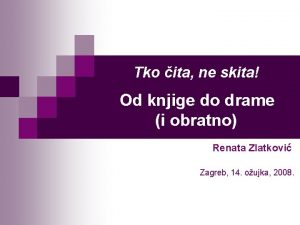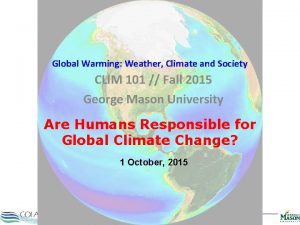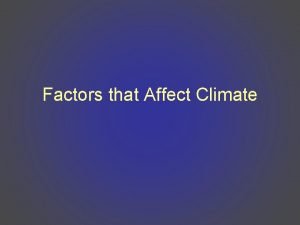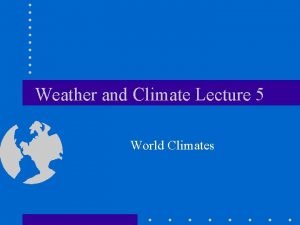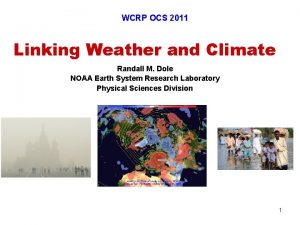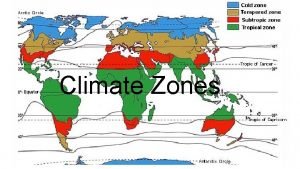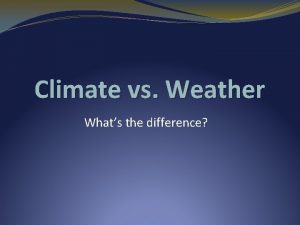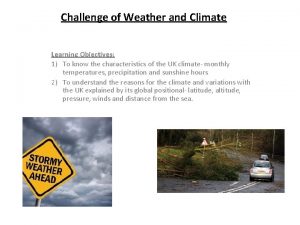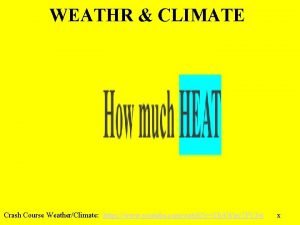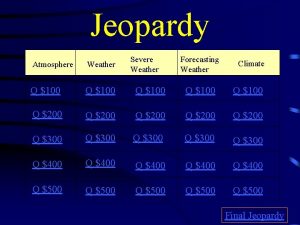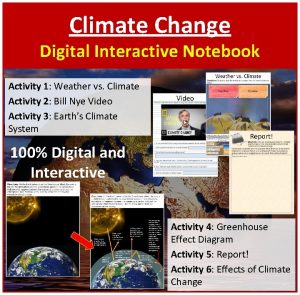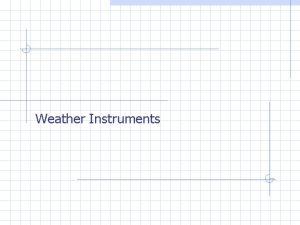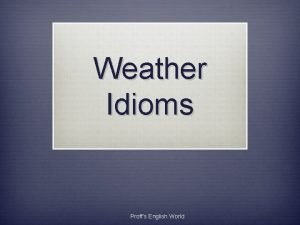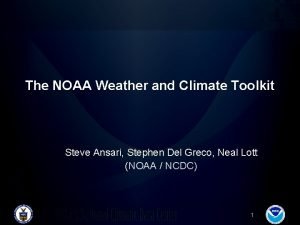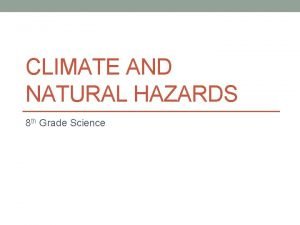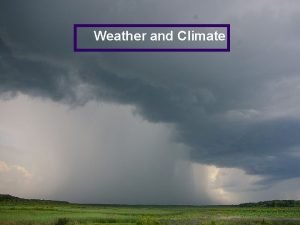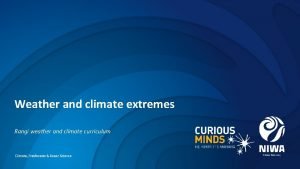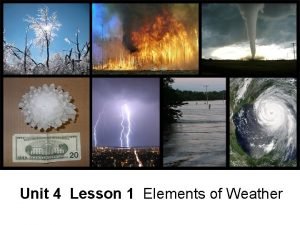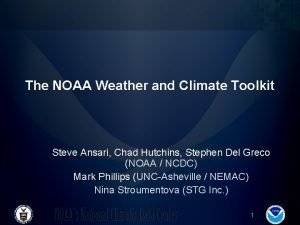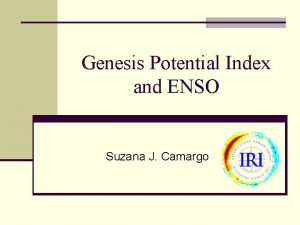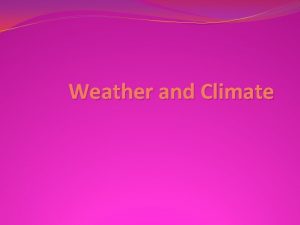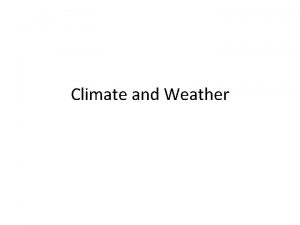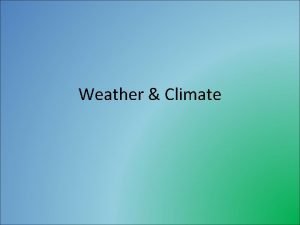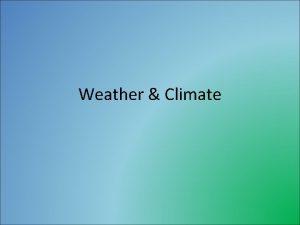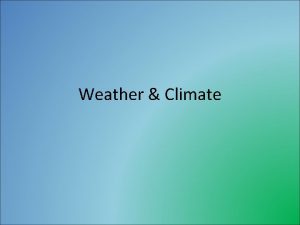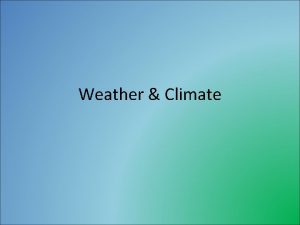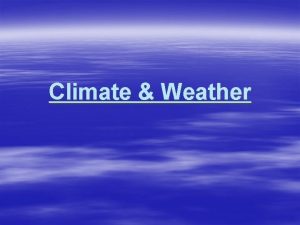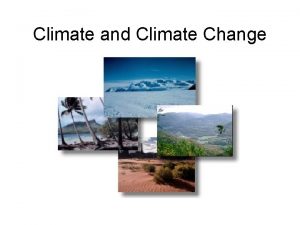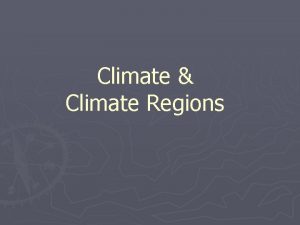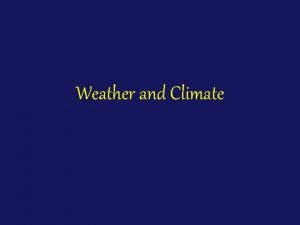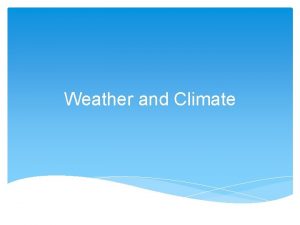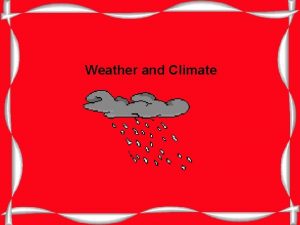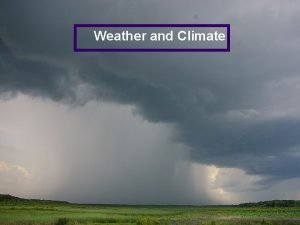Climate and Weather Suzana J Camargo Weather Climate









































- Slides: 41

Climate and Weather Suzana J. Camargo

Weather


Climate - Temperature

Seasons

Climate - Precipitation

What happened in December 2004?


Temperatures – December 2004

IRI Forecast for MJJ 2005

Why forecasts? n Water Management n Health n Agriculture n Populations n Fisheries n Economy

How do we measure temperature and precipitation? n Surface Data – over land: station data – temperature, pressure, humidity, cloud cover, rate of precipitation… 60 stations in 1875 7000 stations inn 2005

Balloons n Rawinsonde – meteorological device attached to a balloon that measures: temperature, pressure, humidity, winds at various altitudes n After World War II – launched by plane twice daily at the major airports

Radar data

Satellite Data

How do we know about past climates? n PALEOCLIMATOLOGY: n Study of the climate when records of temperature, precipitation were NOT available. n PROXYS: records of climate preserved in different elements of nature

Historical Data n Historical documents contain information about past climates. n Examples: farmers’ logs, travelers’ diaries, letters, newspapers. 1370 -1879 Historical grape harvest dates used to reconstruct summer temperatures in France

Corals – sea temperature


Coral reefs areas


Fossil Pollen n All flowering plants produce pollen grains. n Different plants produce different types (shapes) of pollen. n Pollen is well preserved in sediment layers of ponds, lakes and ocean. n Each layer: which plants were growing at that time.

TODAY 18, 000 years ago

Tree-Rings n Tree growth is influenced by climatic conditions. n Patterns in tree rings: width, density, composition reflect variations in climate. n Temperate climates: distinct growing season. n Trees: hundred of years old – record of climate in centuries to millennia.

Locations of tree-rings studies

Tree-rings information from different sources:


Drought in tree-ring records DROUGHT

ICE CORES n Ice accumulated from snowfall over thousands of years in high mountains and polar ice caps. n Scientists drill through deep ice to collect ice cores. n Ice cores contain air bubbles, dust, different elements that can be used to interpret past climate.

Vostok temperature record 250, 000 years ago Present climate


Ocean core sediments n Billions of tons of sediments accumulate on the ocean floor yearly. n Scientists drill the ocean floor to obtain sediment cores. n Sediments include fossils and chemicals that are used to interpret past climates.





Why should we study past climates ?


Global Warming

Green House effect

Can we do anything to stop? YES!!
 Suzana camargo
Suzana camargo Jose camargo melo
Jose camargo melo Suzana krevc
Suzana krevc Senjanin tadija analiza
Senjanin tadija analiza Suzana tajnik
Suzana tajnik Dragan rangelov
Dragan rangelov Suzana hitrec
Suzana hitrec Dipl med techn
Dipl med techn Suzana zvonar
Suzana zvonar Suzana laban nestorovic
Suzana laban nestorovic Metka cesar
Metka cesar Suzana planeja ir a praia
Suzana planeja ir a praia Cerebral aqueduct
Cerebral aqueduct Suzana lopes salgado ribeiro
Suzana lopes salgado ribeiro Suzana lopes salgado ribeiro
Suzana lopes salgado ribeiro Sugeriranje
Sugeriranje Strah od knjige suzana tamaro analiza
Strah od knjige suzana tamaro analiza Suzana kristek
Suzana kristek Suzana leskovar
Suzana leskovar Climate change 2014 mitigation of climate change
Climate change 2014 mitigation of climate change World geography today
World geography today Weather climate and society
Weather climate and society What is this
What is this Weather and climate similarities
Weather and climate similarities Conclusion of weather and climate
Conclusion of weather and climate 12 climate zones map
12 climate zones map Whats the difference between weather and climate
Whats the difference between weather and climate Objectives of weather and climate
Objectives of weather and climate Weathevr
Weathevr Crash course kids weather
Crash course kids weather What causes warm air to rise brainpop
What causes warm air to rise brainpop Weather and climate jeopardy
Weather and climate jeopardy Weather and climate interactive activities
Weather and climate interactive activities Tools to measure weather
Tools to measure weather Idioms about weather and climate
Idioms about weather and climate Poem of seasons
Poem of seasons Noaa toolkit
Noaa toolkit Bill nye weather and climate worksheet
Bill nye weather and climate worksheet L
L Kahoot quiz
Kahoot quiz Elements of weather lesson plan
Elements of weather lesson plan Noaa climate toolkit
Noaa climate toolkit















